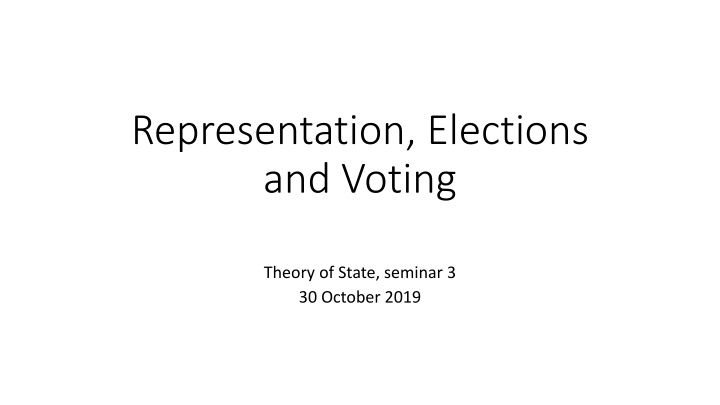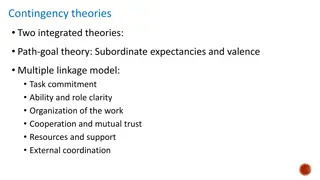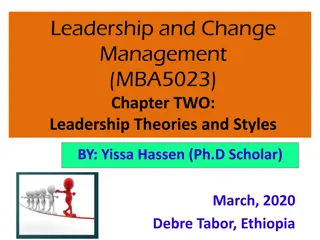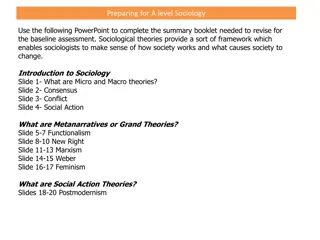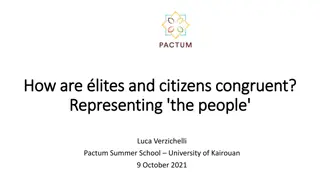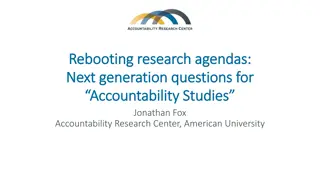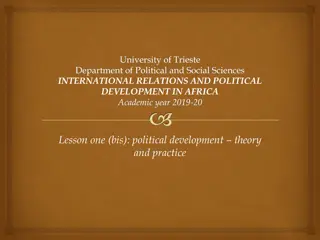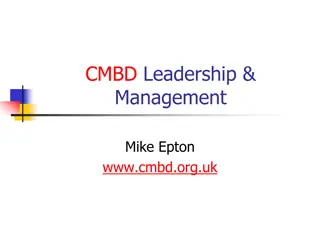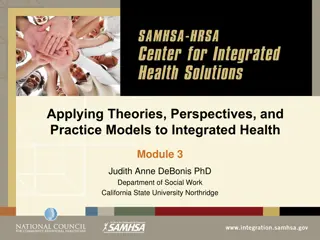Theories of Representation: Examining Political Accountability and Public Leadership
Explore the diverse models of representation in political systems, from the trustee and delegate models to the mandate and resemblance models. Should elected officials strictly adhere to campaign promises, lead public opinion, serve party mandates, or mirror societal demographics? Delve into the nuances of political representation and ponder the balance between accountability and leadership in democratic governance.
Download Presentation

Please find below an Image/Link to download the presentation.
The content on the website is provided AS IS for your information and personal use only. It may not be sold, licensed, or shared on other websites without obtaining consent from the author.If you encounter any issues during the download, it is possible that the publisher has removed the file from their server.
You are allowed to download the files provided on this website for personal or commercial use, subject to the condition that they are used lawfully. All files are the property of their respective owners.
The content on the website is provided AS IS for your information and personal use only. It may not be sold, licensed, or shared on other websites without obtaining consent from the author.
E N D
Presentation Transcript
Representation, Elections and Voting Theory of State, seminar 3 30 October 2019
Theories of representation Should elected politicians be bound by policies and positions outlined during an election and endorsed by the voters, or is it their job to lead public opinion and thereby help to define the public interest?
Trustee model Although all individuals have a right to be represented, not all political opinions are of equal value. -> a system of plural voting Whereas education may certainly be of value in aiding the understanding of intricate political and economic problems, it is far less clear that it helps politicians to make correct moral judgements about the interests of others
Delegate model A delegate is a person who acts as a conduit (i.e. pipeline) conveying the views of others, while having little or no capacity to exercise his or her own judgement or preferences. In ensuring that representatives are bound to the interests of their constituents, it tends to breed narrowness and foster conflict. Politicians are forced to reflect the views of their constituents or even pander to them, and are thus not able to mobilize the people by providing vision and inspiration.
Mandate model In winning an election, a party gains a popular mandate that authorizes it to carry out whatever policies or programmes it outlined during the election campaign. In effect, politicians serve their constituents not by thinking for themselves or acting as a channel to convey their views, but by remaining loyal to their party and its policies. Even if voters are influenced by policies, it is likely that they will be attracted by certain manifesto commitments, but be less interested in, or perhaps opposed to, others.
Resemblance model A representative government would constitute a microcosm of the larger society, containing members drawn from all groups and sections in society and in numbers that are proportional to the size of the groups in society at large. Only people who come from a particular group, and have shared the experiences of that group, can fully identify with its interests. The result would be social division and conflict, with no one being able to defend the common good or advance a broader public interest. Such a government would reflect that society s weaknesses as well as its strengths.
Theories of representation: summary Should elected politicians be bound by policies and positions outlined during an election and endorsed by the voters, or is it their job to lead public opinion and thereby help to define the public interest? Four principal models of representation: trusteeship delegation the mandate resemblance
Elections: fundamental questions 1. Which offices? elected vs. non-elected offices 2. Who can vote? census (qualification) vs. equal access 3. How are votes cast? electoral systems: 2 main models 4. Competitive or non-competitive?
Functions of elections The conventional view Elections are a mechanism through which politicians can be called to account ad forced to introduce policies that somehow reflect public opinion. Bottom-up functions. The radical view Elections are a means through which governments and political elites can exercise control over their populations, making them more quiescent, malleable and, ultimately, governable. Top-down functions.
Party-identification model Electors are people who identify with a party, in the sense of being long-term supporters who regard the party as their party. Early political socialisation. Stability and continuity. However: partisan dealignment.
Sociological model Electors tend to adopt a voting pattern that reflects the economic and social position of the group to which they belong. Class, gender, ethnicity, religion, region. interest plus socialisation approach to voting However: class dealignment.
Rational-choice model Electors decide their party preference on the basis of personal self- interest. They behave like consumers expressing a choice amongst the available policy options. issue voting Pluralism, individualism, postmodernism. However: pluralism of issues, limits of the electorate
Dominant-ideology model Electors are shaped by a process of ideological manipulation and control. Their position depends on how it has been presented to them through education, by the gov t and, above all, by the media. The media are able to distort the flow of political communications, both by setting the agenda for debate and by structuring preferences and sympathies.
Voting behaviour: summary Short-term vs. long-term influences Four principal models of voting behaviour: party-identification model sociological model rational-choice model dominant-ideology model
Elections: case study my vote goes to: assign numbers 1-4 (1=best) negative vote? (1 party only) x conservative party (center-right) 4 1 left-liberal party (progressive) x traditionalist left-wing (soc-dem) nationalist party (euro-sceptical) 3 transparency party (modern, young) alternative centrist party (catch-all) 2 christian democrats (conservative)
